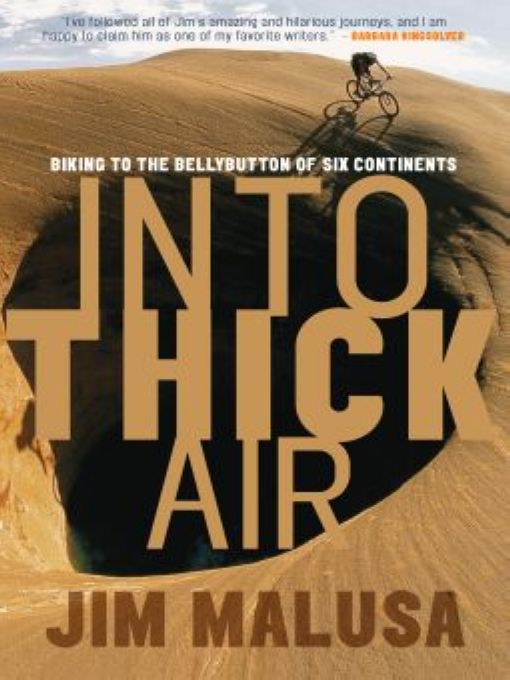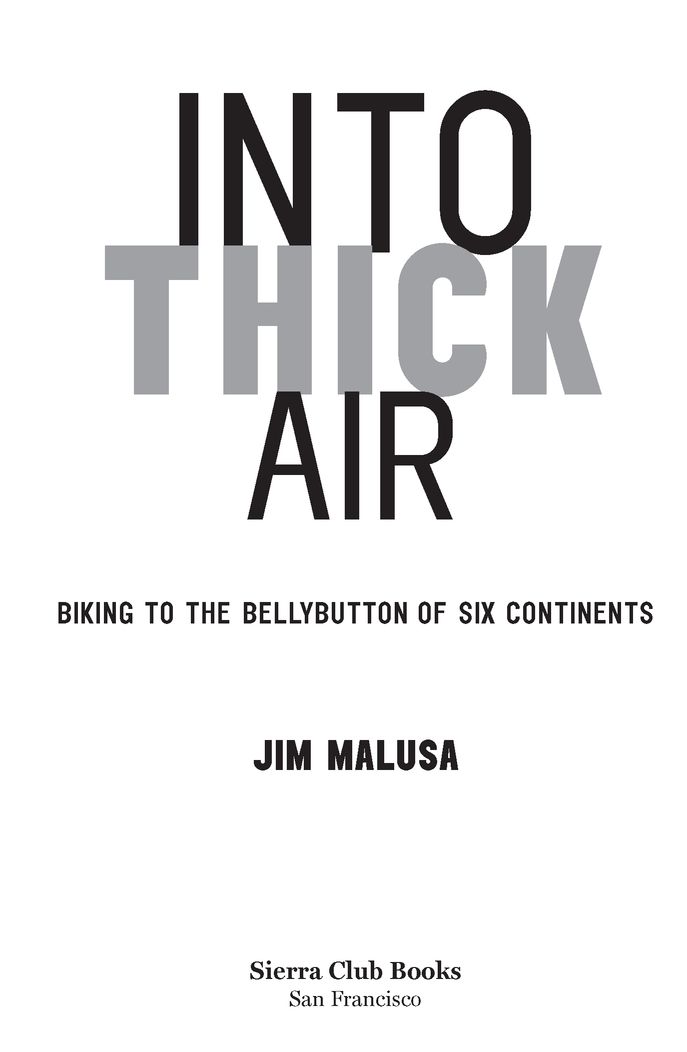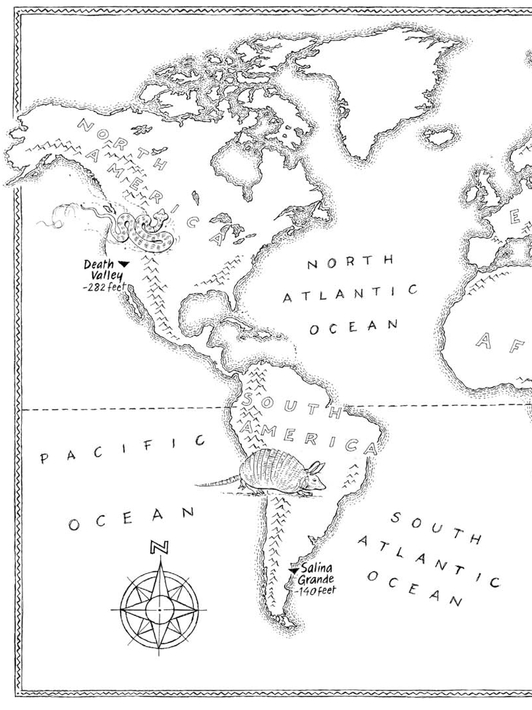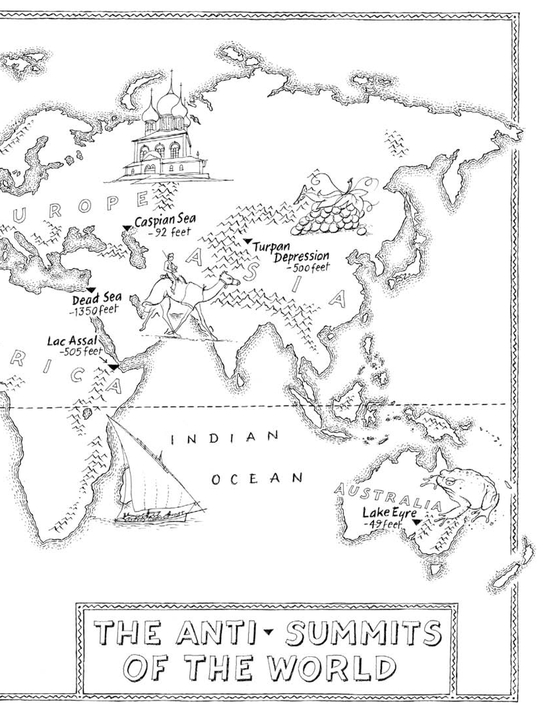Into Thick Air
Authors: Jim Malusa


Table of Contents
Â
Â
Â
Â
Â
Â
Â
Â

For Mom and Dad,
who made me
who made me
CREDITS FOR REPRINTED MATERIAL
Permission to reprint copyrighted material is gratefully acknowledged:
Â
“Death Valley Dolly,” from
Demon Box
by Ken Kesey, copyright © 1986 by Ken Kesey. Used by permission of Viking Penguin, a division of Penguin Group (USA) Inc.
Demon Box
by Ken Kesey, copyright © 1986 by Ken Kesey. Used by permission of Viking Penguin, a division of Penguin Group (USA) Inc.
Â
Lines from
Waiting for Godot: A Tragicomedy in Two Acts
by Samuel Beckett, copyright © 1954 by Grove Press Inc. Copyright © renewed 1982 by Samuel Beckett. Used by permission of Grove/Atlantic, Inc.
Waiting for Godot: A Tragicomedy in Two Acts
by Samuel Beckett, copyright © 1954 by Grove Press Inc. Copyright © renewed 1982 by Samuel Beckett. Used by permission of Grove/Atlantic, Inc.
Â
“Window on the Body” in
Walking Words
by Eduardo Galeano, copyright © 1993, translation copyright © 1995 by W. W. Norton. Used by permission of W. W. Norton & Co.
Walking Words
by Eduardo Galeano, copyright © 1993, translation copyright © 1995 by W. W. Norton. Used by permission of W. W. Norton & Co.
Â
Lines from verses by the poets Bill Neidjie and Sarah Flora, copyright © 1995 by Bill Neidjie and Sarah Flora. Courtesy of Kakadu Aboriginal Traditional Owners and Director of National Parks, Australia.
Â
Lines by Dick Wick Hall from
The Salome Sun: Dick Wick Hall's Salome Sun Newspaper,
1925â1926, copyright © 1998 by Laughing Desert Enterprises. Used by permission of the author's granddaughter, Robin R. Cutler.
The Salome Sun: Dick Wick Hall's Salome Sun Newspaper,
1925â1926, copyright © 1998 by Laughing Desert Enterprises. Used by permission of the author's granddaughter, Robin R. Cutler.
I turned down into the valley,
wishing to examine the bottom, and
a little curious, too, to indulge the
fancy of taking a ride below the
proper level of the earth and ocean.
wishing to examine the bottom, and
a little curious, too, to indulge the
fancy of taking a ride below the
proper level of the earth and ocean.
âArthur Woodward,
Camels and
Surveyors in Death Valley
, 1861
Camels and
Surveyors in Death Valley
, 1861
Â
Â
Â
Â
Â
Get a bicycle. You will not regret it.If you live.
âMark Twain, “Taming the Bicycle”


One of the advantages of cycling
is that it automatically prevents
a journey from becoming an
Expedition.
is that it automatically prevents
a journey from becoming an
Expedition.
âDervla Murphy,
Full Tilt: From
Ireland to India with a Bicycle,
1965
Full Tilt: From
Ireland to India with a Bicycle,
1965
INTRODUCTION
An Odd Character in the Bush
THE CLOSEST I'VE COME TO AN EXPEDITION was my honeymoon, six months on bicycles with no particular destination. Fate had dealt our little team two leaders and no followers. We survived because Sonya and I were linked not only by marriage but also, for better or worse, by physiology. We had ants in our pants. Like dogs sticking their heads out of car windows, we liked feeling the world go by. All we really needed was a map.
I'm a sucker for a pretty map, and a few years after the honeymoon I received as a gift
The Times Atlas of the World.
It was the size of an oven door, and with a little free time and just one beer it was easy to picture places where rain hardly ever falls or snow comes in August, where people love Jesus or bend toward Mecca. To my eyes, the best map of all was a colored topographic plate labeled “China, West.”
The Times Atlas of the World.
It was the size of an oven door, and with a little free time and just one beer it was easy to picture places where rain hardly ever falls or snow comes in August, where people love Jesus or bend toward Mecca. To my eyes, the best map of all was a colored topographic plate labeled “China, West.”
I found it one evening while Sonya fiddled with her flute. Staring out from the center of the map was the yellow oval of the Takla Makan desert, a thousand miles across and rimmed with ice-mountains colored frostbite gray. The towns were arranged like the pearls of a necklace, evenly spaced along the foot of the mountains. They were oases, and the one called Turpan sat within a deep green oval. That shade of green appeared nowhere
else on the map, because no other place was like Turpanâit was sunk five hundred feet below sea level.
else on the map, because no other place was like Turpanâit was sunk five hundred feet below sea level.
I urged Sonya, a geologist by training and disposition, to sit down and take a look at the great green dimple in the desert. What in the world, I mused, were those Turpanians doing down there?
Sonya, who fears nothing but sunburn, took a look. “It could be thrusting,” she said with admirable if misplaced focus on the geologic situation at hand. “Or it could be a sunken block.” I said that I meant the people, not the hole. “Who knows?” she saidâand that was mystery enough. Three years had passed since our honeymoon, and we had the itch.
I picked an excessively scenic route via Kazakhstan and Kyrgyzstanâthe back door to China, over the mountains. After one year and several hundred dollars in phone calls to secure the “invitation” each visa required, we flew from our Arizona home to the other side of the earth. With us in the plane were two boxes, and in the boxes were our bicycles and camping gear.
The pedaling made us happy, and the people saved our necks. The mountains were gorgeous and brutal. On our bikes, we were exposed to the winds, the wilds, the works, and this vulnerability pulled kindness from everyone. We lived on flatbread and woolly cheese lumps and fermented mare's milk proffered by Kyrgyz herders wearing coats that were little more than sheep turned inside out, with the original owners evicted.
Three weeks skinnier, we reached the 12,400-foot pass into China. The atlas was right: it was August and snowing. Back in Arizona, we'd imagined summer flurries to be refreshing. We hadn't counted on freezing.
Far below was the Takla Makan, a glowing pool of warmth. The tourist literature insisted that Takla Makan meant “Go in and you don't go out.” I wanted in. People say terrible things about deserts; they give them frightening names like Hell Hole and Satan's Armpit. But to a man standing in a frozen mud rut, going down made perfect sense.
Turpan was a hot and cheerful oasis of not-too-serious Muslims. They placed their faith in fruit. Their grapes and melons were a kind of miracle, grown not with rain but with meltwater from glaciers 18,000 feet above the town. Water was carried from the foot of the mountains in a subterranean waterworks of man-high tunnels dating from the glory days of
the Silk Road. This liquid catacomb beneath the driest place in China was meant to last forever. The tunnels didn't lose water to the desert sun; they were immune to sandstorms; gravity delivered the water to irrigation ditches running along the streets. At day's end, when the donkey carts loaded with raisins quit stirring up the dust, the locals hauled their beds from their mud houses and parked them beside the canals, for the cool of the indigo sky and a little water music.
the Silk Road. This liquid catacomb beneath the driest place in China was meant to last forever. The tunnels didn't lose water to the desert sun; they were immune to sandstorms; gravity delivered the water to irrigation ditches running along the streets. At day's end, when the donkey carts loaded with raisins quit stirring up the dust, the locals hauled their beds from their mud houses and parked them beside the canals, for the cool of the indigo sky and a little water music.
The surrounding desert was nearly rainless yet vaguely aqueous, with nude mountains of paleo-lake sediments sliced by erosion until they looked like shark's teeth, and sand dunes as black as a swamp.
No signs announced our elevation. Perhaps it was just the thick air, but pedaling below the usual level of the sea gave me the juvenile but real pleasure of breaking rules. One day Sonya and I lunched on noodles at a cafe that was no more than a grape trellis and tables with a view of the Tien Shan mountains. The name means “heavenly,” but when I looked up at the dirty glaciers I was thankful for our deliverance from those cold and windy cracks.
Down was better than up, and it was only a matter of time before Turpan's burnt hills and friendly desolation gave me an idea: why not visit the lowest points on the planet? The bellybutton of each continent. The scheme had two golden attributes: I wouldn't need insulated underwear, and I could ride my bicycle.
It was a wonderful and unlikely scheme. Most everyone has such a plan tucked into his or her imagination, including the Turpan watermelon vendor who fancied himself emigrating to the United States and triumphantly returning five years later, quite wealthy yet still pious. The odds were not in his favor, but that really wasn't the point. It was the plan that counted, the pleasure of possibility.
Which is why, upon our return to Arizona, I looked up the lowest place below sea level on each continent. It was easy: each pit was marked on the National Geographic Map of the World. Turpan isn't the nadir of Asiaâthat would be the Dead Sea, on the shaky Israel-Jordan border. The beach of the Dead Sea is 1,350 feet below sea level, the lowest you can go on earth without a submarine or a flashlight.
I discovered that a good bit of Australia drains not to the ocean but into a sump called Lake Eyre, just 49 feet below sea level. In Europe, the lowest you can go is minus 92 feet on the Russian shore of the Caspian Sea. Salina Grande is sunk 140 feet in the center of South America's Valdez Peninsula, in the Patagonian Desert of Argentina. North America's basement, Death Valley, goes deeper, 282 feet below sea level, and only 700 miles from my home in Tucson. And Africa bottoms out at minus 505 feet on the shore of Lac Assal, in the wee country of Djibouti.
I was alarmed that I'd never heard of Djibouti but happy to see that Antarctica's depression is buried under 15,000 feet of ice. I scratched it from the list. I didn't mind a risk so long as it was a warm risk. Way down in the pits, closer to the core of things, I imagined therapeutic sunlight and oxygen galore. Yet nobody, so far as I knew, had ever reached all the world's depressionsâor at least they weren't talking about it. The idea of climbing the Seven Summits, highest on each continent, inspired a race to the top of the world. The Six Sumps were forsaken, the opposite of success, and it was easy to understand why. Take your choice: climber or lowlife.
Other books
The Sheikh's First Christmas - A Warm and Cozy Christmas Romance by Rayner, Holly
My October by Claire Holden Rothman
Play Me, I'm Yours [Library Edition] by Madison Parker
Sister Slam and the Poetic Motormouth Road Trip by Linda Oatman-High
Slipping the Past by Jackson, D.L.
Two Notorious Dukes by Norton, Lyndsey
The Front by Mandasue Heller
Slow Burn by Christie, Nicole
An All-Consuming Fire by Donna Fletcher Crow